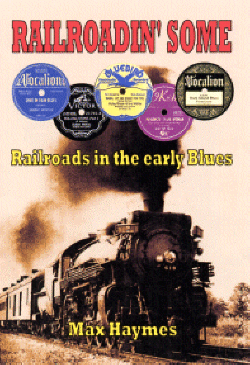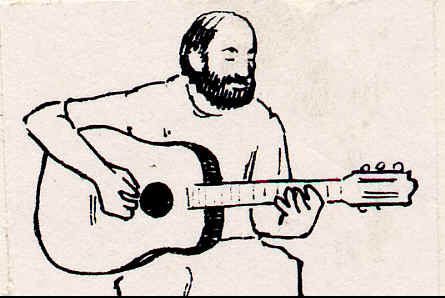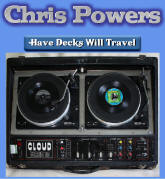
Painting © 2004 Loz
Arkle
Website
© Copyright 2000-2011 Alan White - All
Rights Reserved
Site optimised for Microsoft Internet Explorer



Jumpin' The Blues!
by Steve Pilkington
Jump blues – it’s a term you hear more and more of these days, but what exactly is it? Like many classic American musical forms, jump blues is a hybrid - an inspired mix of blues, swing and jazz. The end result is an intensely exciting, buoyant music which noted music writer, Billy Vera sums up like this, “Marked by a front line of horns (heavy on the saxophones), backed by a strong rhythm section and propelled by a strong ‘back beat’ on drums, the jump combos were long on danceability and short on subtlety.”
Subtlety is not a quality evident in the lyrics of most jump tunes, either. For the most part, they deal with the everyday concerns of their audience – sex, cheating women (or men), sex, alcohol, food, sex, money, cars…oh yes, and sex. In fact, a lot of jump numbers contain the most hilariously vulgar double-entendres this side of a “Carry On” film. If you can listen to songs like “I like My Baby’s Pudding” and “Keep On Churning (Til The Butter Comes)” without cracking a smile, then you’re in urgent need of a sense of humour transplant.
Ironically enough, the goodtime music of jump blues was born during the dark days of World War Two. Black people were moving from the deep south to the big cities, especially on the west coast, to work in the booming defence plants and shipyards, earning more money and enjoying more freedom than they’d previously experienced. Naturally, they brought their traditions with them – including the blues. But downhome country blues was just too rural for their urban lifestyle. So the newly transplanted city dwellers were looking for something fresh – something that glanced back at the old 12-bar blues forms, but looked firmly forward with the exciting jazz and swing music heard in the clubs of their new habitat. The resulting mix was jump blues.
At the same time, many of the black big bands were breaking up, forced off the road by the rising costs of transportation and shortages of fuel, spare parts and tyres. Smaller, more economical seven and eight piece bands were emerging in their place. These new units had to make just as big an impact on their audiences in the noisy clubs as their larger predecessors, so they developed a hard-riffing style that became the foundation of jump blues.
The final piece of the jigsaw was the rise of the independent record companies. Wartime shortages of shellac – the material used to make 78s – meant that the major labels cut down on releases by concentrating on mainstream pop and classical releases. This left the rhythm & blues market wide open for freewheeling entrepreneurs to set up independent outfits, releasing hundreds of classic jump records which were played on the radio, on jukeboxes and in the homes of thousands of black Americans.
The heyday of jump blues was from the mid-40’s to the mid-50’s. During that time, it was hugely popular with black audiences and increasingly with whites too...and that proved to be its undoing. Because once the likes of Bill Haley and Elvis Presley cottoned on, the scene was set for the music’s repackaging in a more acceptable form for mainstream America and rock ‘n’ roll was the result. A few performers like Big Joe Turner managed to survive for awhile in the new climate, but most just faded away. After all, white America didn’t want the likes of Wynonie Harris singing ditties like “I Want My Fanny Brown” to their sons and daughters. Fortunately, the last 30 years have seen jump blues enjoying renewed popularity with a whole new audience, thanks to revival bands and scores of reissues, especially on those little silver discs.
Right, history lesson over, now you’re raring to hear some more of this fantastic music. So where do you start? Here’s a few suggestions:-
Hamhocks & Cornbread (JSP – JSP7748)
4 CDs-worth of shouting, swinging, pulsating, riffing jump blues. From Little Willie Littlefield’s “Happy Pay Day” right through to Joe Houston’s “Cornbread and Cabbage Greens”, this is jump blues heaven. They’re all here – the giants of the genre like Wynonie Harris and Big Joe Turner, along with total unknowns who perhaps made a couple of brilliant records and then disappeared back into obscurity. Despite the fact that a generous 118 tracks are packed into this little humdinger, the quality is A-1 all the way and every single track is a winner. Buy with confidence!
The Big Horn (Proper Box – Properbox 61)
Saxophone players are to jump blues what guitarists are to rock. No jump band is complete without one and they really came into their own during the golden era with their honking, squealing pyrotechnics and exhibitionist stage acts. This is another budget-priced 4 CD set which serves as a perfect introduction to the genre featuring big names like Big Jay McNeely, Joe Houston, Chuck Higgins and future jazz stars like Illinois Jacquet, along with a treasure trove of lesser lights who provide a veritable feast of rhythm & blues sax playing. One listen to this and you’ll be hooked on that honkin’ sound!
Specialty Legends Of Jump Blues Volume 1 (Ace – CDCHD573)
Art Rupe’s L.A.-based Specialty outfit achieved major success with a series of rock ‘n’ roll classics by Little Richard and Larry Williams. But before that, the label enjoyed a run of big sellers in the R&B market with jump blues legends like Roy Milton, Joe and Jimmy Liggins and Joe Lutcher. This compilation gathers together the cream of Specialty’s jump sides and, in doing so, spotlights Art’s talent in capturing the essential excitement of the genre by using high calibre musicians and professional recording techniques. Released in 1994, sadly there’s been no volume 2, but we live in hope!
The Best Of Jump & Jive (Prism – PLATCD 478)
Finally, if you’re looking for a budget-priced compilation to start you off, this is the one. Retailing at around the four quid mark, this 26-track compilation will keep you rocking from start to finish. Featuring a stellar line-up including Louis Jordan, T-Bone Walker, Roy Brown, Wynonie Harris and many more, this is one “Best Of…” that really lives up to its name and, as such, is an essential purchase for jump blues beginners.
If you want to buy any of these CDs, you can usually find them via any of the on-line sites like Play.com and Amazon. It’s also worthwhile checking on ebay, as you can often find all the above and more at bargain prices. So what are you waiting for?
____________________________________________________________________________
Essay © Copyright 2008 Steve
Pilkington. All rights reserved.
Website © Copyright 2000-2008 Alan
White. All Rights Reserved.




